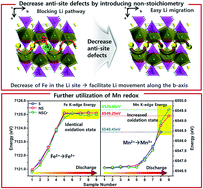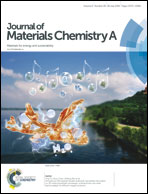Further utilization of a Mn redox reaction via control of structural disorder in olivine systems†
Abstract
Olivine-type phosphates have become cathode materials of great interest in Li rechargeable batteries because of their low cost, high energy density and thermal safety. Strategies such as introduction of non-stoichiometric character, doping, carbon coating, and reduction of particle size have been shown to improve the electrochemical performances of olivine materials. However, the underlying mechanism responsible for electrochemical enhancement by introduction of non-stoichiometric character and doping is not yet well understood at the structure level. In this study, we investigated the structural and electrochemical properties of the equi-sized LiFe0.5Mn0.5PO4, non-stoichiometric LiFe0.5−xMn0.5−xPO4−σ and Cr-doped LiFe0.5−xMn0.5−xCryPO4−σ materials in depth by using synchrotron X-rays, neutrons and electrochemical techniques in order to explore the underpinning science responsible for improved electrochemistry of olivines as a result of non-stoichiometry and supervalent doping. Our neutron diffraction study revealed that anti-site defects are a critical factor for improving the electrochemical performance of olivines, and these defects can be decreased by introducing non-stoichiometry in the crystal structure. The X-ray absorption near edge structure results show that the improved electrochemical performance obtained in non-stoichiometric LiFe0.5−xMn0.5−xPO4−σ and Cr-doped LiFe0.5−xMn0.5−xCryPO4−σ is achieved by a selective further oxidation of Mn, and there is no effect of non-stoichiometry and doping on the Fe2+/Fe3+ redox couple.



 Please wait while we load your content...
Please wait while we load your content...